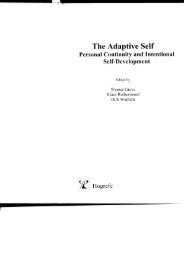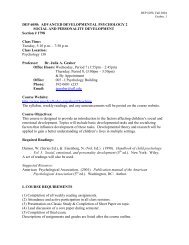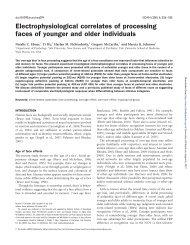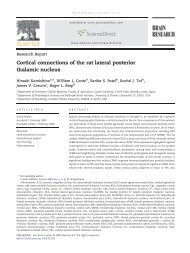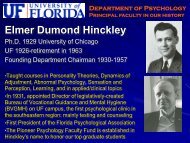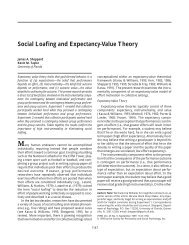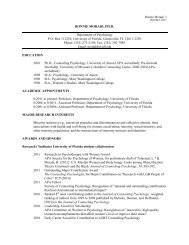Personality theories of successful aging - University of Florida ...
Personality theories of successful aging - University of Florida ...
Personality theories of successful aging - University of Florida ...
Create successful ePaper yourself
Turn your PDF publications into a flip-book with our unique Google optimized e-Paper software.
<strong>Personality</strong> Theories <strong>of</strong> Successful Aging 95<br />
:r siblings regarding verrr<br />
goals. Contextual conthe<br />
boundaries without<br />
l space <strong>of</strong> possible develrtherwise.<br />
1997) provides a useful<br />
'ract over time. This thercess<br />
<strong>of</strong> flexible adaptabiological,<br />
social, and<br />
nger,2006; P. B. Baltes,<br />
enbrenner, 1988; Lerner<br />
cations: (1) Individuals<br />
Lnd limiting boundaries<br />
heir own living contexts<br />
pursuit, and disengage-<br />
; interaction with his or<br />
985; Emmons , 1986; Frergh,<br />
7996; Heckhausen,<br />
l's transactions with the<br />
itations <strong>of</strong> goal-directed<br />
r self, personal goals, bere<br />
is an interplay among<br />
ndtstiidter, 1998).<br />
;) distinguishes two inpersonal<br />
goals. Social<br />
tt age-graded opportu-<br />
,ortunities and limitarse.<br />
For example, they<br />
n. Thereby, age-related<br />
bout the availability <strong>of</strong><br />
(Freund, 2003; Hcckrcial<br />
norms and expcc-<br />
)urces. Through social<br />
ty, social expectations<br />
:nt, selection, pursuit,<br />
>r,7994; Freund, 1997;<br />
sonal beliefs about the<br />
beliefs incorporate insonal<br />
expectations dindividual<br />
selects and<br />
as, in addition to conicious<br />
motives impact<br />
rnality, person-context<br />
nalgoalseems partic-<br />
ularly well suited for a developmental approach to personality <strong>theories</strong> <strong>of</strong> <strong>successful</strong><br />
<strong>aging</strong> as it allows integrating motivational processes into a life span context and<br />
furthers our understanding <strong>of</strong> both the direction <strong>of</strong> development and <strong>of</strong> interindividual<br />
differences in the leuel <strong>of</strong> functioning in various life domains over time. Of<br />
particular importance in this regard is the selection <strong>of</strong> goals from a pool <strong>of</strong> possible<br />
alternatives and the investment <strong>of</strong> resources into the pursuit and maintenance <strong>of</strong><br />
goals, also in the face <strong>of</strong> setbacks and losses. Goal selection and pursuit can improve<br />
individual competences and generate new resources, which can then be used<br />
for further goal attainment.<br />
One <strong>of</strong> the basic assumptions <strong>of</strong> joining an action-theoretical with a life spandevelopmental<br />
perspective in personality <strong>theories</strong> <strong>of</strong> <strong>successful</strong> <strong>aging</strong> is that, in<br />
interaction with a given physical, cultural-historical, and social context, people<br />
actively shape their own developmental context (Brandtstiidter & Lerner, 7999;<br />
Ford, 1987; Freund & Baltes, 2000; Lerner & Busch-Rossnagel, 1981). Goals link<br />
the person to his or her life contexts and thus are central to personality and development<br />
across the life span. In the following, we introduce three approaches that<br />
consider goal selection, initiation <strong>of</strong> goal-related actions, and the investment <strong>of</strong><br />
goal-reiated resources as crucial for achieving desired developmental outcomes.<br />
TuE Rolr or Conr.s aNp GonI-RELATED PRocessgs<br />
roR Succsssr-'u r. Duv pI-oPMENT<br />
By nature, human beings are goal-oriented organisms. They organize their lives<br />
around the pursuit <strong>of</strong> goals that reflect their fundamental needs (e.9., autonomy,<br />
competence, relatedness; Ryan, 1995). Goals provide persons with standards and<br />
ideal outcomes against which they can evaluate their actual level <strong>of</strong> functioning,<br />
their progress in the direction <strong>of</strong> higher levels <strong>of</strong> functioning, and the effectiveness<br />
<strong>of</strong> their goal-related behaviors (Carver & Scheier, 1990). Empirical evidence<br />
has shown that personal goals are positively related to well-being (Emmons,7986;<br />
Omodei & Wearing, 1990; Palys & Little, 1983; Sheldon & Elliot, 1999). What are<br />
the mechanisms underlying this relation? That is, how do goals and goal-related<br />
processes inf luence well-being and <strong>successful</strong> <strong>aging</strong>?<br />
There are different views on hor,v goals affect well-being. Tt is <strong>of</strong>ten argued that<br />
<strong>successful</strong> development implies that individuals succeed in progressing toward<br />
their goals or reaching desired states (M. M. Baltes & Carstensen, 1996; Maslow,<br />
1954; McClelland, 1987). Humanistic psychology proposes that a person's sense <strong>of</strong><br />
well-being depends on the person's progress toward his or her goals, especially<br />
when these are in accord with "organismic" or "innate" needs (Maslow, 1954;<br />
Rogers, 1963; Ryan, 1995; see also Brunstein, Schultheiss, & Crdssman, 1998). Other<br />
authors argue that having goals can in itself be a predictor <strong>of</strong> life satisfaction<br />
(Brunstein, Schultheiss, & Maier, 1999; Emmons, 7996). Still others posit that not<br />
goals themselves but rather the al'ailability <strong>of</strong> goal-related resources is positively<br />
related to life satisfaction (Diener & Fujita, 1995). Finally, Brandtstddter and<br />
Rothermund (2002) maintain that goals can ambivalently affect well-being. They<br />
argue that neither goals nor resources themselves bring about goal attainment or<br />
<strong>successful</strong> development. In fact, unattainable goals can lead to dissatisfaction and<br />
depression if they are not abandoned or readjusted.<br />
Thus, setting and pursuing challenging but attainable goals and standards are<br />
important self-regulatory processes conducive to <strong>successful</strong> <strong>aging</strong> (Brandtsttidter<br />
& Renner, 1990; Carver & Scheier, 7981,7982; Freund & Baltes,2000; Heckhausen,



